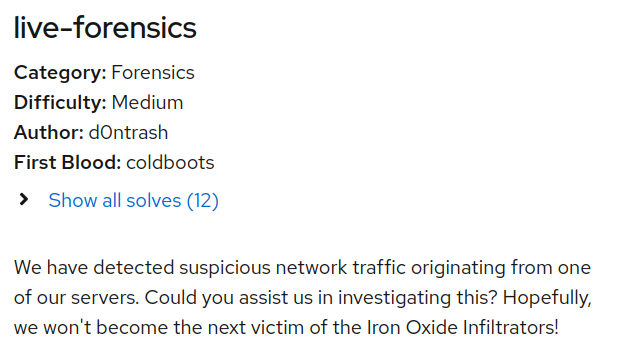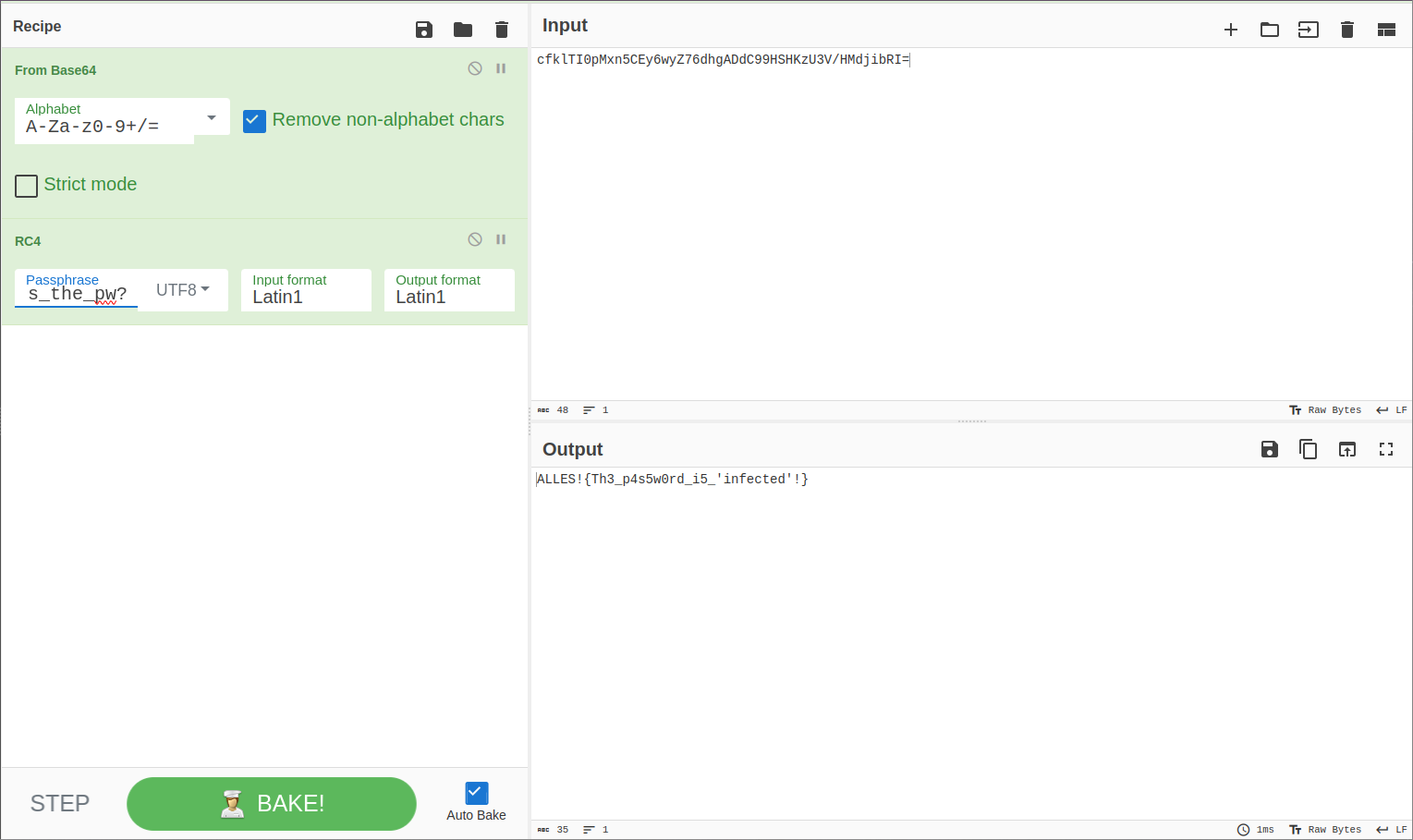(Forensics - CCCampCTF 2023) live-forensics

TL;DR: Analysis of a dropper Linux malware.
Description: We have detected suspicious network traffic originating from one of our servers. Could you assist us in investigating this? Hopefully, we won’t become the next victim of the Iron Oxide Infiltrators!
Introduction
We are given SSH access, with root permissions, to a live machine.
When we connect to the machine, a binary corrosion located in home directory is ran as root.
[rlaspina@ARCH-RLS live_forensics] $ ssh -p 31222 e128435411528e7b20bafe14-live-forensics@challenge.master.camp.allesctf.net
=============
Forwarding to ctf@e128435411528e7b20bafe14-live-forensics
Good luck!
=============
To run a command as administrator (user "root"), use "sudo <command>".
See "man sudo_root" for details.
ctf@live-forensics-bfqqetfjre:~$ ls
corrosion
[1]+ Done sudo /home/ctf/corrosion
ctf@live-forensics-bfqqetfjre:~$
We then download the binary with scp. A quick analysis with VirusTotal gives nothing. Thus, we will briefly reverse it with Ghidra. It is written in Rust, so it will be a bit more painful.
The Injector
It appears that the binary looks for a running dropbear process and for its libc mapping in memory. Then, the binary will drop a custom library /tmp/libimplant.so decrypted “on-the-fly”. It will afterwards replace the libc in the memory of the dropbear process with the dropped library in order to inject malicious code.
sysinfo::traits::SystemExt::new_all();
processes = sysinfo::traits::SystemExt::processes_by_exact_name(system,"dropbear",8);
process = <alloc::boxed::Box<I,A>as_core::iter::traits::iterator::Iterator>::next(processes);
process = core::option::Option<T>::expect(process,"Process not found!",0x12,&PTR_s_src/main.rs/libc.Cant_read_libc!_555556172bb8);
pid = <sysinfo::linux::process::Process_as_sysinfo::traits::ProcessExt>::pid(process);
pid = <sysinfo::common::Pid_as_sysinfo::common::PidExt>::as_u32(pid);
pid = <T_as_core::convert::TryInto<U>>::try_into(pid);
pid = core::result::Result<T,E>::unwrap(pid,extraout_EDX,&PTR_s_src/main.rs/libc.Cant_read_libc!_555556172bd0);
pid = nix::unistd::Pid::from_raw(pid);
local_1c = pid;
uVar1 = <T_as_core::convert::Into<U>>::into(pid);
get_libc_map(opt_libc_mapping,uVar1);
core::option::Option<T>::expect(libc_mapping,opt_libc_mapping, "libc map not found!",0x13,&PTR_s_src/main.rs/libc.Cant_read_libc!_555556172be8);
dlopen_offset = proc_maps::<impl_proc_maps::linux_maps::MapRange>::filename(libc_mapping);
dlopen_offset =
core::option::Option<T>::unwrap(dlopen_offset._0_8_,dlopen_offset._8_8_,&PTR_s_src/main.rs/libc.Cant_read_libc!_555556172c00);
dlopen_offset = std::path::Path::to_str(dlopen_offset._0_8_,dlopen_offset._8_8_);
dlopen_offset = core::option::Option<T>::unwrap(dlopen_offset._0_8_,dlopen_offset._8_8_,&PTR_s_src/main.rs/libc.Cant_read_libc!_555556172c18);
dlopen_offset = get_function_offset(dlopen_offset._0_8_,dlopen_offset._8_8_,"dlopen",6);
dlopen_offset2 = core::option::Option<T>::expect(dlopen_offset._0_8_,dlopen_offset._8_8_,"Function not found",0x12,&PTR_s_src/main.rs/libc.Cant_read_libc!_555556172c30);
local_18 = dlopen_offset2;
start_libc_mapping = proc_maps::<impl_proc_maps::linux_maps::MapRange>::start(libc_mapping);
if (CARRY8(start_libc_mapping,dlopen_offset2) == false) {
local_10 = start_libc_mapping + dlopen_offset2;
decrypt_payload(&DAT_5555556e760e,0xa2e820,&DAT_5555556e75fc,0x12,"unleash_your_power");
str>::to_owned(str_libimplant,&DAT_5555556e75fc,0x12);
<alloc::string::String_as_core::ops::arith::Add<&str>>::add(path_libc,str_libimplant,"",1);
dlopen_offset = <alloc::string::String_as_core::ops::deref::Deref>::deref(path_libc);
process = write_path_to_process(pid,dlopen_offset._0_8_,dlopen_offset._8_8_);
local_8 = process;
core::ptr::drop_in_place<alloc::string::String>(path_libc);
inject(pid,start_libc_mapping + dlopen_offset2,process);
core::ptr::drop_in_place<proc_maps::linux_maps::MapRange>(libc_mapping);
core::ptr::drop_in_place<sysinfo::linux::system::System>(system);
return;
}
With gdb, I directly jumped to decrypt_payload in order to dump the malicious library libimplant.so. We can next analyze this library in Ghidra.
The Injected
At a first glance, I didn’t know where to search in this huge library. Therefore I searched for the string flag, and then I discovered a very strange function call_home which seems to do GET requests to a C2 server at IP 207.120.7.12 on port 4444.
At this point, my idea was to
- run a local
dropbearprocess, - setup Wireshark in order to record the traffic generated by the malware,
- run the malware.
- get the flag in the capture
And that’s when I fell into the trap… since the malware didn’t look “very malicious”, I was lazy and the end of the CTF was approaching, I didn’t setup a VM and did these steps on my host. Readers, don’t do that. Don’t be lazy, setup a VM. Even in CTF…
I missed a subtility: the malware do some requests with a hash in the URL, and the response of the C2 depends on the hash. Therefore, if the binary is ran from outside the live machine, the malware detects it and… shutdowns the computer… (:
Flag
In the future runs, to avoid the shutdown, I renamed the /bin/shutdown binary so that the shutdown command fails. I restarted the steps above, and I got the following capture:

If we try to browse at these locations, we get the following:


It seems like there is an anti-sandbox protection: the C2 server check the hash in the URL, and don’t give the flag/the decryption key for the flag if the hash is unknown. Additionally, if the response contains the word “SHUTDOWN”, the binary shutdowns the machine.
Then, I investigated how was this hash computed and if it was possible to forge the good hash.
std::env::current_dir();
core::result::Result<T,E>::unwrap(local_ae0,local_ac8,&PTR_s_src/lib.rs/register_agent//get_e_002354a0);
auVar4 = <std::path::PathBuf_as_core::ops::deref::Deref>::deref(local_ae0);
auVar4 = std::path::Path::to_str(auVar4._0_8_,auVar4._8_8_);
auVar4 = core::option::Option<T>::unwrap(auVar4._0_8_,auVar4._8_8_,&PTR_s_src/lib.rs/register_agent//get_e_002354b8);
<D_as_digest::digest::Digest>::digest(local_af0,auVar4._0_8_,auVar4._8_8_);
Actually, this hash is obtained from the current working directory. Since the code is injected in the dropbear process, it is actually the working directory of dropbear.
ctf@live-forensics-imsxxqhzcj:~$ ps aux
USER PID %CPU %MEM VSZ RSS TTY STAT START TIME COMMAND
root 1 0.0 0.0 2888 1040 ? Ss 18:00 0:00 /bin/sh -c /opt/run.sh
root 7 0.0 0.0 4360 3172 ? S 18:00 0:00 /bin/bash /opt/run.sh
root 8 0.0 0.0 79720 7252 ? Sl 18:00 0:00 dropbear -FBREkp 1024
root 9 0.0 0.0 4792 2168 ? D 18:00 0:00 dropbear -FBREkp 1024
ctf 10 0.5 0.0 4624 3744 pts/0 Ss 18:00 0:00 -bash
ctf 27 0.0 0.0 7060 1572 pts/0 R+ 18:00 0:00 ps aux
ctf@live-forensics-imsxxqhzcj:~$ sudo cat /proc/8/environ
KUBERNETES_SERVICE_PORT_HTTPS=443KUBERNETES_SERVICE_PORT=443HOSTNAME=live-forensics-imsxxqhzcjPWD=/home/ctfHOME=/rootKUBERNETES_PORT_443_TCP=tcp://172.21.0.1:443SHLVL=1KUBERNETES_PORT_443_TCP_PROTO=tcpKUBERNETES_PORT_443_TCP_ADDR=172.21.0.1KUBERNETES_SERVICE_HOST=172.21.0.1KUBERNETES_PORT=tcp://172.21.0.1:443KUBERNETES_PORT_443_TCP_PORT=443PATH=/usr/local/sbin:/usr/local/bin:/usr/sbin:/usr/bin:/sbin:/bin_=/usr/sbin/dropbear
I found out that on the live machine, dropbear was ran from /home/ctf. Therefore, I created a /home/ctf directory locally, and repeated previous steps. And this time, the result is different!

If we browse to the accessed locations, we can this time retrieve a RC4 encryption key as well as the encrypted flag.


After decoding/decryption with CyberChef, we finally get the flag.

FLAG: ALLES!{Th3_p4s5w0rd_i5_'infected'!}
Conclusion
A great thanks to the author, I had a lot of fun solving this chall.
Dear reader, stay safe, use a VM… :)